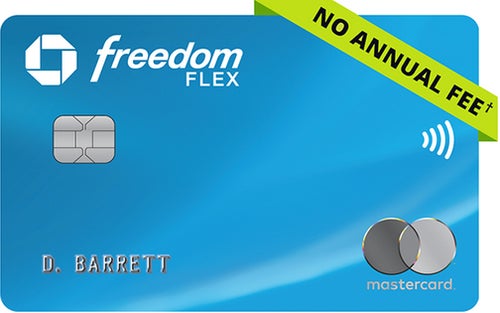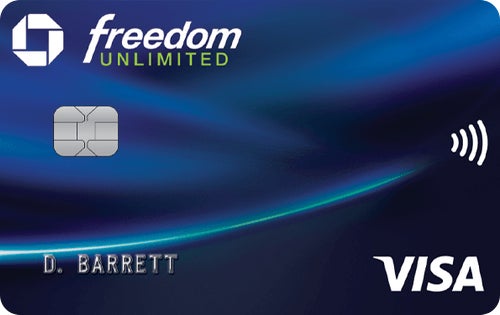Summary
If you are you looking for an inexpensive way to get a large influx of Ultimate Rewards points, the Chase Freedom Flex and Freedom Unlimited cards offer large bonuses with low spending thresholds.
The content on this page is accurate as of the posting date; however, some of our partner offers may have expired. Please review our list of best credit cards, or use our CardMatch™ tool to find cards matched to your needs.
If you’re looking for a way to get a large influx of Ultimate Rewards points, there is great news for Chase members: Both the Chase Freedom Flex℠ and Chase Freedom Unlimited cards offer a high cash bonus for a low spend threshold.
The Chase Freedom Flex can earn you a $200 bonus if you spend $500 in the first three months. The Chase Freedom Unlimited is currently offering an extra 1.5 percent cash back on all purchases (on up to $20,000 spent in the first year), providing an opportunity for new cardholders to earn $300 in cash back.
However, since these two cards are both cash back cards issued by Chase, how do you choose which is better for you?
Which Chase Freedom card is better in the first year?
That depends largely on your spending habits. While the two cards share certain earning categories, they still have different rewards earning structures.
The Freedom Unlimited offers a flat rate of 1.5 percent cash back on purchases outside of bonus categories. Plus, in your first year with the card, you’ll earn an additional 1.5 percent cash back on all purchases, including those in bonus categories.
This means you can get 6.5 percent cash back on travel purchased through Chase Ultimate Rewards, 4.5 percent back on drugstore purchases and dining at restaurants and 3 percent on everything else (on up to $20,000 in purchases in the first year).
The Freedom Flex card offers 5 percent cash back in rotating bonus categories that you must activate each quarter (on up to $1,500 in purchases, then 1% cash back). You’ll also get $200 if you spend $500 in the first three months with the card.
For many cardholders, the Chase Freedom Flex card should offer greater value, assuming you maximize your spending in its quarterly bonus categories. That said, if you’re not able to maximize the Freedom bonus categories, the Freedom Unlimited card might be a better choice thanks to its higher rewards rate on general purchases.
Comparing the Chase Freedom Flex and Freedom Unlimited cards
 |  | |
|---|---|---|
| Rewards rate |
|
|
| Annual fee | $0 | $0 |
| Introductory offer |
|
|
| Estimated value in first year ($15,900 annual spend) | $761 | $666 |
Of course, there’s nothing to stop you from applying for both cards and potentially earning both cards’ sign-up bonuses. The Chase Freedom Flex and Freedom Unlimited cards go nicely together — you can use the Chase Freedom Flex card to earn 5 percent cash back on its quarterly bonus categories and the Chase Freedom Unlimited card to earn 1.5 percent cash back on everything else. Then, use either card at drugstores and restaurants and on travel purchases in the Ultimate Rewards portal.
Recent changes to the Chase Freedom cards’ sign-up bonus
While some rewards cards frequently update their sign-up bonuses, the offers on the Chase Freedom cards are fairly consistent. Recently, however, we have seen increased welcome offers, with both cards adding a higher-than-usual cash back rates on top of their familiar $200 flat cash bonus.
| Chase Freedom Flex card recent changes | |
|---|---|
| Current | $200 if you spend $500 in the first 3 months |
| Previous | $200 if you spend $500 in first 3 months, plus 5% cash back on grocery store purchases in first year (on up to $12,000 in spending, not including Target or Walmart purchases) |
| Previous | $200 if you spend $500 in first 3 months |
| Previous | $200 if you spend $500 in first 3 months, plus 5% cash back on grocery store purchases in first year (on up to $12,000 in spending, not including Target or Walmart purchases) |
| Chase Freedom Unlimited card recent changes | |
|---|---|
| Current | Extra 1.5% on all purchases (on up to $20,000 spent) |
| Previous | $200 if you spend $500 in first 3 months, plus 5% cash back on grocery store purchases in first year (on up to $12,000 in spending, not including Target or Walmart purchases) |
| Previous | $200 if you spend $500 in first 3 months |
| Previous | $200 if you spend $500 in first 3 months, plus 5% cash back on grocery store purchases in first year (on up to $12,000 in spending, not including Target or Walmart purchases) |
| Previous | $150 if you spend $500 in first 3 months |
Who is eligible to apply for the sign-up bonus?
New cardholders who have not received a sign-up bonus for the same card within the past 24 months are eligible to earn the bonus with the Chase Freedom cards. Of course, you have to qualify for the cards first, which means you’ll need a credit score in the good to excellent range (at least 670).
Chase doesn’t appear to have a hard limit on how many cards you own, though it may deny your application if you have too large of a credit limit across your other Chase cards. Also, while there is no strict rule on how many Chase cards you can apply for within a certain timeframe, many applicants report a limit of one to two new cards per month.
Chase has recently cracked down on applicants who have opened several credit cards at once. Though it’s not an official policy, Chase appears to be enforcing a “5/24” rule on new credit card applications. If you have opened at least five credit card accounts in the past 24 months with any issuer (not just Chase), your application will likely be denied. The rule seems to apply to any credit card account that shows up on your credit report, including co-branded store cards and authorized user accounts. (On the plus side, business credit cards that don’t appear on your personal credit report do not affect your chances of being approved.)
Best ways to spend 20,000 Ultimate Rewards points
The Chase Freedom Flex and Chase Freedom Unlimited cards offer a wide array of options for redeeming or transferring your points. You can redeem points as statement credits, as direct deposits into a bank account, for gift cards or travel or to purchase merchandise through Amazon.com or the Chase Pay app.
As cash back cards, the Chase Freedom cards offer a flat 1 cent value on most redemption options. However, there are a few options that you’ll want to avoid. Our table below shows that Amazon.com and Chase Pay purchases are valued at only 0.8 cents per point:
Redemption options for Chase Freedom cards
| Redemption option | Point value (cents) | Value of 20,000 points |
|---|---|---|
| Statement credit | 1 | $200 |
| Direct deposit | 1 | $200 |
| Gift cards | 1 | $200 |
| Ultimate Rewards portal travel | 1 | $200 |
| Amazon.com purchases | 0.8 | $160 |
| Chase Pay purchases | 0.8 | $160 |
You can also transfer points from the Chase Freedom cards to certain Chase Ultimate Rewards cards, such as the Chase Sapphire Preferred Card and Chase Sapphire Reserve card. As you can see from the table below, transferring your points to one of these cards will allow you to get more value out of your sign-up bonus. You get a 25 percent to 50 percent bonus on your points if you redeem for travel through the Chase Ultimate Rewards portal, depending on which card you own.
Also, both Sapphire cards allow you to transfer your points at 1:1 value to one of Chase’s many travel partners to get even higher values on your points. For instance, we value Southwest Rapid Rewards points at 1.5 cents on average, according to Bankrate (note the value can vary widely on the ticket that you purchase), which means the 20,000-point bonus can net you $300 of value on average when used for Southwest airfare.
Redemption options for Chase Sapphire cards
| Redemption option | Point value (cents)* | Value of 20,000 points |
|---|---|---|
| Chase Sapphire Reserve — 50% redemption bonus | 1.5 | $300 |
| Chase Sapphire Preferred — 25% redemption bonus | 1.25 | $250 |
| Singapore Airlines transfer | 2.2 | $440 |
| British Airways transfer | 0.7 | $140 |
| Southwest Airlines transfer | 1.5 | $300 |
| JetBlue transfer | 1.4 | $280 |
| United Airlines transfer | 1.1 | $220 |
| World of Hyatt | 2.1 | $420 |
| Air France transfer | 1.2 | $240 |
| Virgin Atlantic transfer | 2.6 | $520 |
| Marriott Rewards transfer | 0.7 | $140 |
| IHG transfer | 0.7 | $140 |
*Based on Bankrate’s point and mile valuations
An extra $500 per year
In addition to a sign-up bonus, the Chase Freedom cards offer a referral bonus worth up to $500 each year. Chase’s “Refer-a-Friend” program gives Freedom cardholders $100 cash back for each person they refer who is approved for the Freedom card — up to five people per year.
To take part in the promotion, enter your last name, zip code and the last four digits of your credit card on Chase’s Refer-a-Friend page. On the following page, enter the first name and email address of each person you wish to invite. You also have the option to post an invitation link to Facebook or Twitter or refer friends through the Chase app.
Editorial Disclaimer
The editorial content on this page is based solely on the objective assessment of our writers and is not driven by advertising dollars. It has not been provided or commissioned by the credit card issuers. However, we may receive compensation when you click on links to products from our partners.






